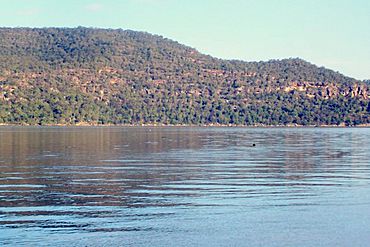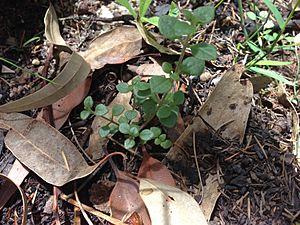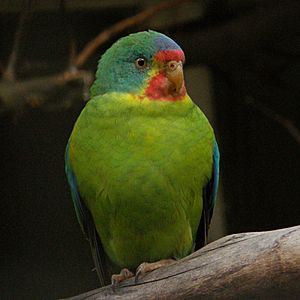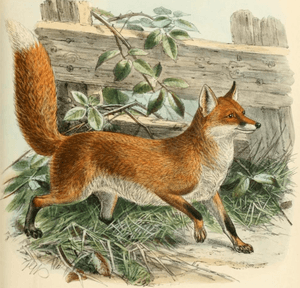Brisbane Water National Park facts for kids
Quick facts for kids Brisbane Water National ParkNew South Wales |
|
|---|---|
|
IUCN Category II (National Park)
|
|

Looking towards the national park from Bar Point, across the Hawkesbury River.
|
|
| Nearest town or city | Woy Woy |
| Established | September 1959 |
| Area | 115.06 km2 (44.4 sq mi) |
| Managing authorities | NSW National Parks & Wildlife Service |
| Website | Brisbane Water National Park |
| See also | Protected areas of New South Wales |
The Brisbane Water National Park is a special protected national park in the Central Coast region of New South Wales, Australia. This big park covers about 11,506 hectares (that's like 28,432 football fields!). It's located about 47 kilometers north of Sydney. You can find it 10 kilometers west of Woy Woy and 12 kilometers southwest of Gosford.
Contents
Exploring Brisbane Water National Park
The park has many fun walking trails. Some are easy, while others are a bit tougher. One popular walk leads to Pindar Cave. You can get there easily by public transport! Just take the train to Wondabyne railway station. This station is a "request-stop," meaning the train only stops if someone wants to get on or off.
The famous Great North Walk, which goes all the way from Sydney to Newcastle, also passes through this park.
The park is surrounded by natural features and roads. To the south, it meets the Hawkesbury River. To the west, you'll find parts of the Pacific Highway and the M1 Pacific Motorway. These roads, along with Peats Ridge Road, also form the northern border. To the east, it's bordered by the Brisbane Water, the Central Coast railway line, and nearby towns. Some roads and bridges, like the Hawkesbury River railway bridge, even go right through different parts of the park.
A Special Place for Nature
Brisbane Water National Park is like a "living space" for plants and animals. It's a safe place for them to live and adapt, especially with climate change happening. The park's large size and shape help animals and plants move and adjust.
This park also protects important waterways like the lower Hawkesbury River, Broken Bay, Pittwater, and Brisbane Water. It's also home to many important Aboriginal sites, including amazing rock art. The rocks in the park are mostly sandstone, which is a type of rock made from sand.
Plants and Animals of the Park
This national park is super important because it provides safe places for many animals to nest and raise their young. For some species, it's the only secure land they have to hide from human activity. The park offers essential resources like tree hollows, which many animals need to survive.
The main types of plants you'll see are open forests and woodlands. In sheltered valleys and along streams, you might even find small rainforest areas. The park has 20 different plant communities. Sadly, all of them are considered endangered in New South Wales. Five of these are even critically endangered under a national law called the Environment Protection and Biodiversity Conservation Act.
Blue Gum High Forest
One critically endangered plant community is the Blue Gum High Forest. This is a tall, open forest where the Sydney blue gum tree is the most common. Other trees like blackbutt and forest oak also grow here. This forest only grows in places with lots of rain and good soil. Only about 4.5% of the original Blue Gum High Forest is left. It relies on birds and mammals to spread its seeds and doesn't do well after fires. The park helps protect these special forests.
Rare and Endangered Plants
Brisbane Water National Park is home to many rare and endangered plants. These plants show us how the environment has changed over thousands of years. Some are the last remaining groups of plants that used to be very common before land was cleared for towns and farms.
The park has an amazing variety of plants, with 814 different species recorded! This huge diversity is due to different types of rocks, soils, water, sunlight, and fire history. Ten of these plants are very rare, and many others are uncommon.
Some vulnerable plant species in the park include:
- Thick-leaf star-hair (Astrotricha crassifolia)
- Camfield's stringybark (Eucalyptus camfieldii)
- Deane's paperbark (Melaleuca deanei)
- Grevillea shiressii
The endangered Somersby mintbush (Prostanthera junonis) is also found here.
The donkey orchid (Diuris bracteata) was thought to be extinct, but it has been seen in the park recently! This orchid grows in dry woodlands with lots of grass. The only known donkey orchids left are in the Gosford and Wyong areas.
Camfield's Stringybark
The vulnerable Camfield's stringybark (Eucalyptus camfieldii) is now only found in small numbers, mostly in national parks around Sydney. This plant can be a small shrub or a tree up to 9 meters tall. It has heart-shaped leaves when it's young. Too many fires or not enough fires can threaten its survival. The main threats are:
- Competition from invasive plants that aren't native.
- Habitat damage from weeds.
- Fires that happen too often or not often enough.
- Loss of habitat due to new buildings.
- Low genetic diversity because there are so few of them left.
Somersby Mintbush
The endangered Somersby mintbush (Prostanthera junonis) is only found in 9 spots in the Somersby Plateau area. This bush grows low to the ground, usually no taller than 30 cm. Its flowers are pale purple to almost white. Most of the remaining Somersby mintbush plants are in Brisbane Water National Park. They face similar threats to the Camfield's stringybark, like habitat damage, competition from weeds, and bad fire patterns.
Amazing Animals of the Park
The park provides a safe home for many vulnerable and endangered animals. In total, 261 different animal species have been recorded here. All of them are protected by law, except for invasive species.
The park is home to:
- 26 native mammal species.
- 30 frog species (that's 9 out of 27 types found in Australia!).
- 50 reptile species (one-third of Australia's reptile types!).
Birds of Brisbane Water National Park
Over 150 types of birds have been seen in the park. Many birds have lost their homes due to human development, so this park is very important for them. Some birds that are rare in the Sydney area due to habitat loss include:
- Collared sparrowhawk
- Pacific baza
- Lewin's rail
- Buff-banded rail
- Yellow-tailed black cockatoo
- Glossy black cockatoo
- Gang-gang cockatoo
- Powerful owl
- Australian masked owl
- Red-browed treecreeper
The endangered swift parrot (Lathamus discolour) visits the park between March and October. They fly here all the way from Tasmania! They look for food and tree hollows to rest in. The critically endangered regent honeyeater (Anthochaera Phrygia) has also been seen in the park. These birds are at a very high risk of extinction. Protecting them helps many other woodland animals too.
Other birds that visit the park during their migrations are the white-throated needletail, the Caspian tern, and the white-bellied sea-eagle. These birds are protected by agreements with countries like China, Korea, and Japan.
Other Endangered Animals
Besides birds, the park is home to other endangered species:
- Giant burrowing frog (Heleioporus australiacus)
- Green sea turtle (Chelonia mydas)
- Koala (Phascolarctos cinereus)
- Spotted-tailed quoll (Dasyurus maculatus)
- Long-nosed potoroo (Potorous tridactylus)
- Grey-headed flying fox (Pteropus poliocephalus)
- Large-eared pied bat (Chalinolobus dwyeri)
- New Holland mouse (Pseudomys novaehollandiae)
Vulnerable species in the park include:
- Rosenberg's goanna (Varanus rosenbergi)
- Eastern pygmy possum (Cercartetus nanus)
- Squirrel glider (Petaurus norfolcensis)
Many of these animals are endangered or vulnerable because they are losing their homes. Their habitats are being broken up, and dead trees and logs are removed. Also, feral animals are introduced, and fires are not happening in the right way. Climate change is also a big threat.
The spotted-tailed quoll is in serious trouble. They need a lot of space to find food, so they mostly live in large national parks. They also need safe dens in tree hollows, logs, or caves. When their habitat is broken into smaller pieces, they don't have enough space, food, or nesting spots to survive.
The koala (Phascolarctos cinereus) and the squirrel glider (Petaurus norfolcensis) are marsupials that live in trees. They depend on the size and type of trees, soil, rainfall, and climate. Squirrel gliders need tree hollows for shelter and flowers from certain plants for food. As towns and farms grow, these animals lose their homes, making protected areas like this park even more important. Even large birds like the Powerful owl (Ninox strenua) need tree hollows for nesting and enough prey to eat. If there are fewer small mammals for them to hunt, it affects the owls too.
Challenges for the Park
Brisbane Water National Park faces several environmental threats. One big problem is feral animals that don't belong there. This includes foxes (Vulpes vulpes), wild dogs (Canis familiaris), and cats (Felis catus). Because the park is close to towns, these animals are a big concern. Wild dogs and cats hunt native animals, compete for food, and can spread diseases. Wild dogs often hunt larger animals like wallabies, while cats hunt smaller animals like reptiles and small mammals. These pests can cause native species to disappear forever.
Invasive weeds are another threat. Even though the soil isn't very fertile, once weeds start growing, they can quickly take over and harm native plants. This is a big problem for endangered plants like the Blue Gum High Forest and Somersby mintbush. Weeds can also change how the park's ecosystem works, affecting fire patterns and how nutrients move in the soil. Since towns are close by, weed seeds are often brought into the park, so regular work is needed to control them. The biggest threat from weeds is that they reduce the park's amazing biological diversity.
The park is also surrounded by busy areas like towns, factories, and farms. The streams that flow into the park often start outside its borders. This means that pollution, like dirt and extra nutrients from nearby runoff, can flow into the park's waterways. This pollution can encourage weed growth and harm aquatic plants.
Managing the Park
The National Parks and Wildlife Service (NPWS) manages Brisbane Water National Park. Their job is super important for protecting the park's biodiversity and providing a safe place for Australian native plants, animals, and ecosystems. They run programs to remove weeds and control pests to help native habitats recover. They also plan how to manage fires to protect lives, Aboriginal sites, historical sites, and nature.
Because the land around the park was easy to settle, the park itself is often "hemmed in" by development. This makes managing the park difficult, especially with new building projects happening nearby. For example, a rubbish tip is located inside the park, which creates management issues. Runoff from farms, factories, and homes outside the park can harm the plants in the creeks. Also, trails for fire management need to be carefully planned to avoid causing erosion. Dirt bikes and four-wheel drives are not allowed in the park because they damage plants and soil, and cause erosion. It's hard to stop them because there are many ways to enter the park.
See also
 In Spanish: Parque nacional Agua de Brisbane para niños
In Spanish: Parque nacional Agua de Brisbane para niños






